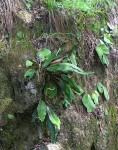Elaphoglossum kuhnii Hieron.
Synonyms |
|
|---|---|
Common name |
|
Description |
Rhizome creeping; rhizome scales up to 5 mm long, ovate to lanceolate, subentire, tapering to a point, pale brown, sometimes with a dark margin. Fronds firmly herbaceous to coriaceous, simple, tufted, erect or arching. Stipes densely set with spreading, pale to reddish-brown ovate-lanceolate, ciliate scales of about 3 mm long. Stipes of fertile fronds (up to 25 cm) usually longer than those of sterile fronds (up to 11 cm long). Sterile lamina up to 9-30 × 1.3-2.7 cm, narrowly elliptic to narrowly oblanceolate in outline, apex rounded to pointed, base wedge-shaped to tapering, slightly oblique, thinly set on the upper surface and densely set on the undersurface with pale brown to reddish-brown, translucent, oblong-lanceolate to round, ciliate scales, becoming glabrous with age. Fertile lamina up to 8 × 1.2 cm, verry narrowly oblong to linear, apex rounded, base tapering, upper surface scaly, under-surface covered completely with sporangia. |
Notes | Can be distinguished from E. deckenii by having pale brown (not dark brown to black) rhizome scales. |
Derivation | kuhnii: named after J. Kuehn, German botanist and author of Filices Africanae (1868) and Filices Deckenianae (1867). |
Habitat | Montane and riverine forest, montane grassland among boulders or light shade in woodland. |
Distribution worldwide | See African distribution. |
Distribution in Africa |
Cameroon, Equatorial Guinea (incl. Bioko), Liberia, Malawi, Sierra Leone, Zimbabwe. |
Growth form |
Epiphytic, lithophytic. |
Literature |
|
